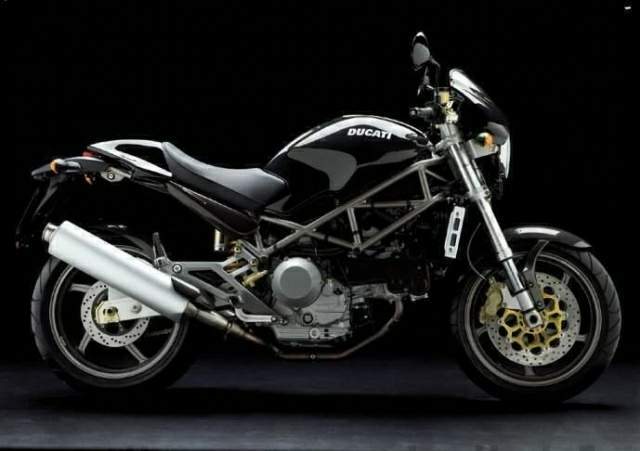
|
|
|
|
|
|
Classic Bikes
Custom Bikes
Individual
Racing Bikes AJP
AJS
Aprilia
Ariel
Avinton / Wakan
Bajaj
Benelli
Beta
Bimota
BMW
Brough Superior
BRP Cam-Am
BSA
Buell / EBR
Bultaco
Cagiva
Campagna
CCM
CF Moto
Combat Motors
Derbi
Deus
Ducati
Excelsior
GASGAS
Ghezzi Brian
Gilera
GIMA
Harley Davidson
Hero
Highland
Honda
Horex
Husaberg
Husqvarna
Hyosung
Indian
Jawa
Kawasaki
KTM
KYMCO
Laverda
Lazareth
Magni
Maico
Mash
Matchless
Mondial
Moto Guzzi
Moto Morini
MV Agusta
MZ / MuZ
NCR
Norton
NSU
Paton
Peugeot
Piaggio
Revival Cycles
Roland Sands
Royal Enfield
Sachs
Sherco
Sunbeam
Suzuki
SWM
SYM
Triumph
TVS
Ural
Velocette
Vespa
Victory
Vincent
VOR
Voxan
Vyrus
Walt Siegl
Walz
Wrenchmonkees
Wunderlich
XTR / Radical
Yamaha
Zero
Video
Technical
Complete Manufacturer List
|
Ducati Monster S4
By 2000, the 900 Monster was suffering attacks from several rival models, all with stronger powerplants. Cagiva's Raptor 650 and 1000 in particular were potent threats to the air-cooled Monster range. So Ducati launched a new Monster, based around the engine and chassis from the ST4 sports-tourer. A re-tuned 916 engine gave the S4 the power it needed to take on its rivals, while a strong chassis with typical Ducati handling gave the S4 accomplished track handling.
The trademark Monster styling remained, only slightly marred by the large water radiator slung below the steering head, and many detail changes have tidied up the normally enclosed 916 engine.
New, higher-specification suspension units were also fitted. Fully adjustable Showa 43mm (1.7in) upside-down front forks and Sachs rear shock gave the new flagship Monster the sort of first-class damping and springing typical of a luxury Italian sports machine. The Brembo front brakes are common to the other Monsters, but are very effective on this faster machine.
While the new Monster S4 retains the same basic styling of the classic Monster range, there are several detail cosmetic changes. A neat headlight flyscreen offers little practical wind protection, but looks very stylish. Lightweight carbon-fibre parts abound, including exhaust heat shields, sidepanels, mudguard and timing belt covers.
On the road, the S4 offers much more satisfying performance than the air-cooled 900. The engine is flexible and strong throughout the rev range, combining the muscular mid-range of the air-cooled engines with prodigious top-end power. The sports suspension gives a firm ride, which can be choppy over poor road surfaces, but is ideal on smooth racetracks. The S4 matches its competitors on styling and handling, although its 916cc engine just falls short of Cagiva's Raptor 1000 unit.
Review
Let face it, even back in 1993, when the 900 cc
Ducati Monster was unveiled, there was nothing monstrous about the 80 horsepower
that the old air-cooled mill produced. Even back then, dinosaurs like GSX-Rs,
FZRs and ZX-11s roamed planet earth, and the name "Monster" seemed a bit
presumptuous to say the least. Nevertheless, the not-so-aptly named bike turned
out to be Ducati's salvation. Tens of thousands of Monsters in various
displacements became a Ducati staple and opened new markets for a factory that
has always been identified with uncompromising hyper-sport torture racks. Source Motorcycle.com

|
|
|
Any corrections or more information on these motorcycles will be kindly appreciated. |